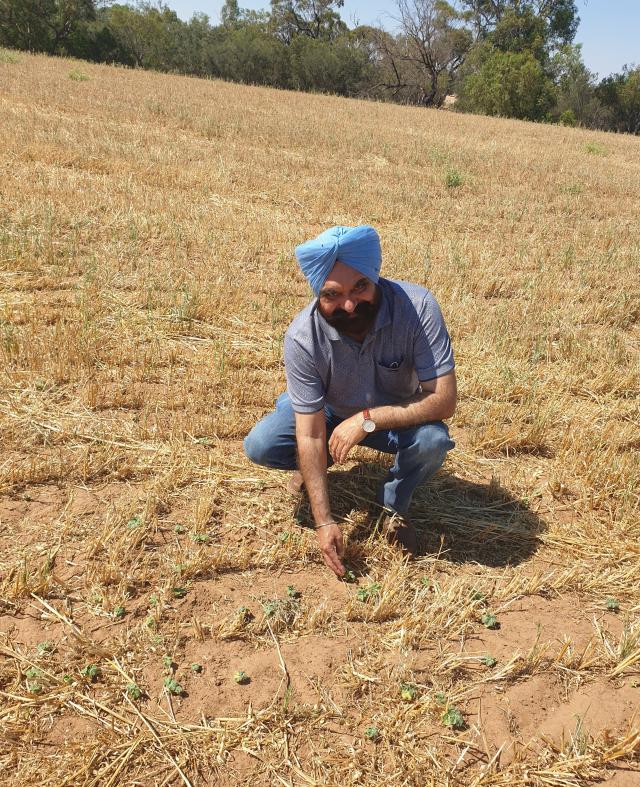Glyphosate alternatives for summer and pre-seeding knockdown weed control
At a glance
- Glyphosate resistance is becoming more of an issue for weeds in the WA grainbelt and alternative herbicides are needed for summer and pre-seeding weed control.
- Summer weeds can rob subsequent crops of soil nitrogen and stored soil water and therefore need to be eradicated before crops are sown.
- In a trial researching the effectiveness of glyphosate alternative herbicides on summer weed control, a range of registered non-glyphosate herbicides and herbicide mixes provided excellent control of summer weeds.
- Glyphosate resistant ryegrass, young capeweed and mature sow thistle were almost completely eradicated by a range of registered non-glyphosate herbicides and herbicide mixes applied at pre-seeding or early winter in 2022.
Controlling summer weeds reduces the carryover of pests and diseases by preventing a green bridge effect. It can also significantly prevent subsequent crops from experiencing other weed detrimental effects. If left uncontrolled summer weeds can reduce subsequent crop yields due to:
- Weeds reducing crop emergence through physical and/or chemical interference.
- Weeds locking away large amounts of nitrogen so it’s not available to the crop.
- Weeds using stored soil water and reducing the amount available to the crop.
Traditionally, glyphosate has been commonly used to control summer and pre-seeding weeds, with up to four applications of glyphosate applied a year in some paddocks. However, with resistance to glyphosate becoming an increasing issue, alternative herbicides are needed.
In a Department of Primary Industries and Regional Development (DPIRD) funded project, research scientist Dr Harmohinder Dhammu conducted a mix of field and glass house trials to determine weed control efficiency (WCE). He looked at glyphosate alternative herbicides and herbicide mixes on common summer weeds - caltrop, afghan melon, sow thistle, button and windmill grass, as well as pre-seeding weed control of glyphosate-resistant tillering ryegrass, capeweed and sow thistle.
Trial results indicated there was a range of herbicides and herbicide mixes that can provide as good, if not better, WCE than glyphosate. Dr Dhammu found a mix of glufosinate and fluroxypyr 333 at 300mL/ha and 2,4-D amine 625 at 1.6L/ha on 2-8 leaf afghan melon plants recorded 100% WCE, similar to the control that glyphosate 570 at 2L/ha provided.
Many of the herbicide mixes trialled for controlling button and windmill grass at 5-7 leaf tillering plants achieved 100% WCE under screen house conditions, outperforming glyphosate 570 at 2L/ha with 57% WCE in button grass and 21% WCE in windmill grass.
The herbicides and herbicide mixtures tested that achieved total WCE were:
- Paraquat 125g/L + amitrole 250g/L (eg., Alliance®) at 4L/ha.
- Paraquat 300g/L + amitrole 12g/L (eg., Guerilla®) at 2L/ha and haloxyfop 520 (eg., Verdict®) at 150mL/ha.
- Glufosinate 200 (eg. Basta®, Biffo®) at 3.75L and paraquat 250 (eg., Gramoxone®) at 2.4L/ha.
The best treatment for control of glyphosate-resistant tillering ryegrass pre-seeding in a field trial, with 95% WCE, was paraquat 300g + amitrole 12g/L at a rate of 2L/ha, while glyphosate 570 at 2L/ha was on par with the untreated control in the trial.
For more information on Dr Dhammu’s research findings listen to the Grains Convo podcast episode Major WA weed trends of 2022 and summer weed management.
This webpage will be updated with a link to Dr Dhammu’s 2023 GRDC Grains Research Update paper in March when it becomes available.

